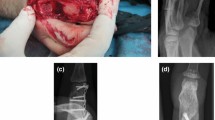Summary
In 31 (out of 48) patients with 43 (out of 63) replanted or revascularized digits or parts of the extremities a study of long-term results was performed. Their ages were below 16 years at the time of injury. The results concerning function, sensitivity, cold intolerance, growth disturbance, patient acceptance and occupational changes were evaluated. Early complications consisted of venous stasis in 10.6 % (n = 4), skin necrosis of the wound margin in 5.3 % (n = 2) and in finger-tip necrosis in 5.3 % (n = 2). One lower arm and one finger replanted (5.3 %, n = 2) were lost after several revisions due to venous problems. In no case did arterial problems occur. Tendon adhesions were the most common complication in 28.9 % (n = 11), followed by deviation of the axis in a frontal plane of more than 20 ° in 13.3 % (n = 5) and by joint instability in 5.3 % (n = 2). Only twice (5.3 %) did ankylosis or in another case osteomyelitis of the proximal phalanx result. At amputation level II (between the DIP joint and the nail root), 37.5 % (n = 3) developed a reduction of range of active movement (RAM) with a mean of 31.7 °, and once an arthrodesis was necessary, whereas 50 % (n = 4) of the patients have full range of active motion. At amputation level III (between the MP and DIP joint) 52.7 % (n = 10) developed a reduction of RAM at the PIP joint with a mean of 29.5 °, and twice an arthrodesis was necessary, whereas 26.4 % (n = 5) of the patients have full range of active motion. Of the patients 78.9 % (n = 15) developed a reduction of RAM at the DIP joint with a mean of 35.7 °, and twice an arthrodesis was necessary. Only twice was ankylosis present, but 10.5 % (n = 2) of the patients have full range of active motion. Excellent sensory recovery was observed with a mean dynamic two-point discrimination of 4.8 mm. In addition, only 29 % (n = 9) of the patients report a surprisingly low incidence of cold intolerance, which is in contrast to adults with up to 100 % cold intolerance in replanted digits. In 67.7 % a radiologically measured difference of length with a mean of 3.8 mm and clinically measured a difference in the length of the digits with a mean of 4.9 mm was observed without complaints by the patients. Instead, there was moderate discontent with the aesthetically disturbing finger-tip atrophy, which was up to 30 % in 48.4 % of the patients. Of the patients who are now adult, 16.7 % (n = 4) changed their choice of profession due to the trauma or because of the dissatisfactory result. These results and the success rate of 94.7 % suggest the conclusion that one should not hesitate to perform a replantation or revascularization in children with even multiple amputations as the results are excellent.
Zusammenfassung
Bei 31 (von 48) Patienten mit 43 (von 63) replantierten oder revaskularisierten Fingern oder Extremitätenanteilen wurde eine Studie der Langzeitergebnisse durchgeführt, wobei das Alter der Patienten zum Unfallzeitpunkt unter 16 Jahren lag. Es wurden die Ergebnisse in Hinblick auf Funktion, Sensibilität, Kälteintoleranz, Wachstumsstörung, Akzeptanz durch den Patienten sowie auf berufliche Konsequenzen erhoben. Die Untersuchungen ergaben exzellente Rückkehr der Sensibilität sowie gute funktionelle Ergebnisse mit einer nur geringen Rate an Kälteintoleranz. Mit der Erfolgsrate von 94,7 % Einheilung erlauben diese Ergebnisse den Schluß, daß im Kindes- und Jugendalter Replantationen oder Revaskularisationen in jedem Fall und auch bei Mehrfachamputationen indiziert sind und versucht werden sollen.
Similar content being viewed by others
Author information
Authors and Affiliations
Rights and permissions
About this article
Cite this article
Schwabegger, A., Hussl, H., Ninković, M. et al. Replantations in children and youths: long-term results. Unfallchirurg 100, 652–657 (1997). https://doi.org/10.1007/s001130050171
Issue Date:
DOI: https://doi.org/10.1007/s001130050171




